In Summer 2018, TfL called us to a meeting about a planned cycle route from Camden to Tottenham Hale called ‘Cycle Future Route 2’. The original idea had protected cycle lanes on both sides of Camden Road but at that time they planned for the Camden and Islington sections to run northbound on Camden Road and southbound on a parallel route that goes through Camden Square. But early in 2020, TfL changed their mind about giving space for cycling on Camden Road and said that the route should go through Camden Square in both directions. When TfL rationalised the cycle route names last year they called it C50.
During 2021 Camden Council consulted on a scheme that includes a Low Traffic Neighbourhood (LTN) for Camden Square and a set of improvements on the C50 alignment – mainly at junctions. This post is about how the LTN and junction improvements have produced a significant upgrade to what was already a useful cycle route.
There have been negative comments about using a meandering route around Camden Square rather than a more direct route on Camden Road. We have measured the C50 route shown on Map 1 below (1.19 km) and compared it with the distance along Camden Road and down C6 to the junction with C50 (1.08 km). The new scheme provides two-way cycling on Randolph Street so the difference is very small. Quite apart from that, the Camden Square route avoids noise and air pollution and provides a green and pleasant environment.

The Camden Square Low Traffic Neighbourhood
This new Low Traffic Neighbourhood (shown in pale blue on Map 2) came into being in December 2021.
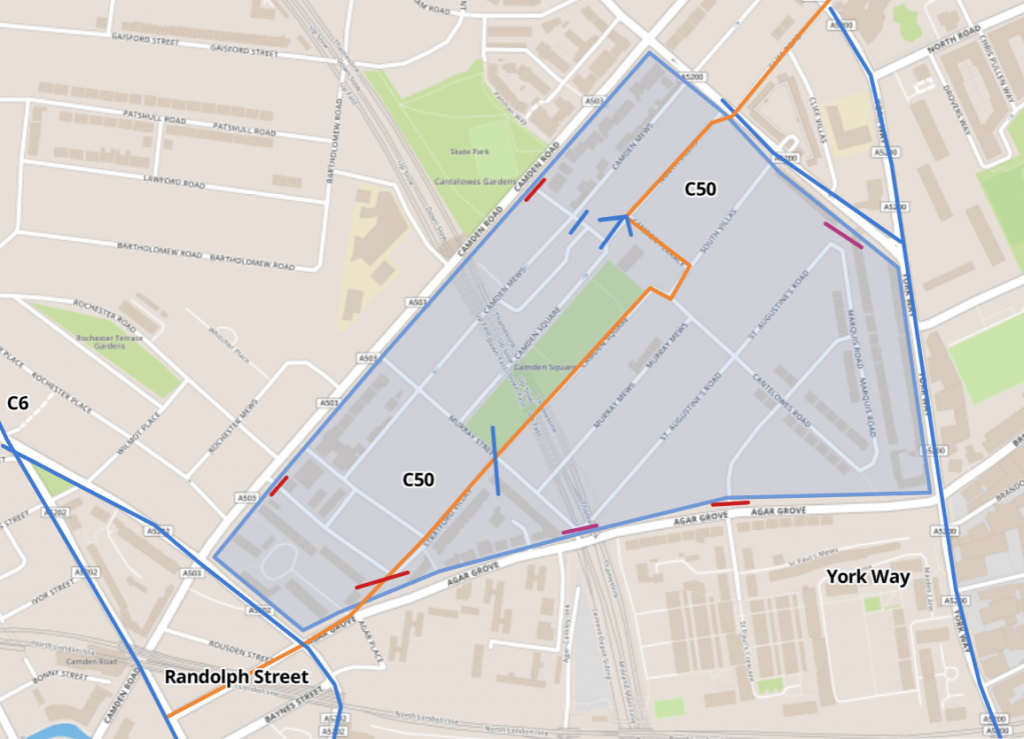
The Camden Square area has been fairly well protected from through motor traffic since filters were installed in the 1970s, closing all of the Agar Grove junctions apart from Murray Street as well as two junctions with Camden Road and another with Camden Park Road (red filters on Map 2). The most serious rat-run was through Murray Street between Camden Road and Agar Grove, particularly by drivers wanting to turn right from Camden Road to reach York Way. This has been cut out by a new diagonal filter across Murray Street at its junction with Stratford Villas and Camden Square (blue line). An additional one-way northbound filter and right turn ban (blue arrow at the bottom of North Villas) prevents drivers entering Murray Street from Camden Road from reaching Camden Park Road and from circling around Camden Square and back to Agar Grove. Another nearby filter prevents all but local traffic from entering Camden Mews from Cantelowes Road.
The diagonal filter
Click to enlarge any photo.


Photo 1 shows the view of the diagonal filter from Stratford Villas: cyclists can go straight on across the filter while motor vehicles have to turn left. Motor vehicles on Murray Street (on the left of the photo) have to give way and then turn right.
Photo 2 shows the view of the diagonal filter from Camden Square (east side): cyclists can go straight on across the filter while motor vehicles have to turn left. Motor vehicles on Murray Street (on the left of the photo) have to give way and then turn right.
The filters at the junction of North Villas and Camden Terrace


The C50 junctions starting at the junction with C6 and working north east
1. Royal College Street / Randolph Street (where C6 meets C50)


This is a priority junction (that is, it doesn’t have signal control). Randolph Street is one-way eastbound for motor traffic but the recent changes provide contraflow cycling. As Royal College Street has priority, westbound cyclists on Randolph Street must give way. For northbound cycles on Royal College Street, a right turn lane has been provided so that they can wait to turn right into Randolph Street; this has been fitted in front of a newly modified bus stop bypass (see Photo 5).
Note: Camden has provided with-flow and contraflow protected lanes through Randolph Street (motor traffic isn’t filtered).


2. St Pancras Way/ Randolph Street – Agar Grove (where C50 meets St Pancras Way)

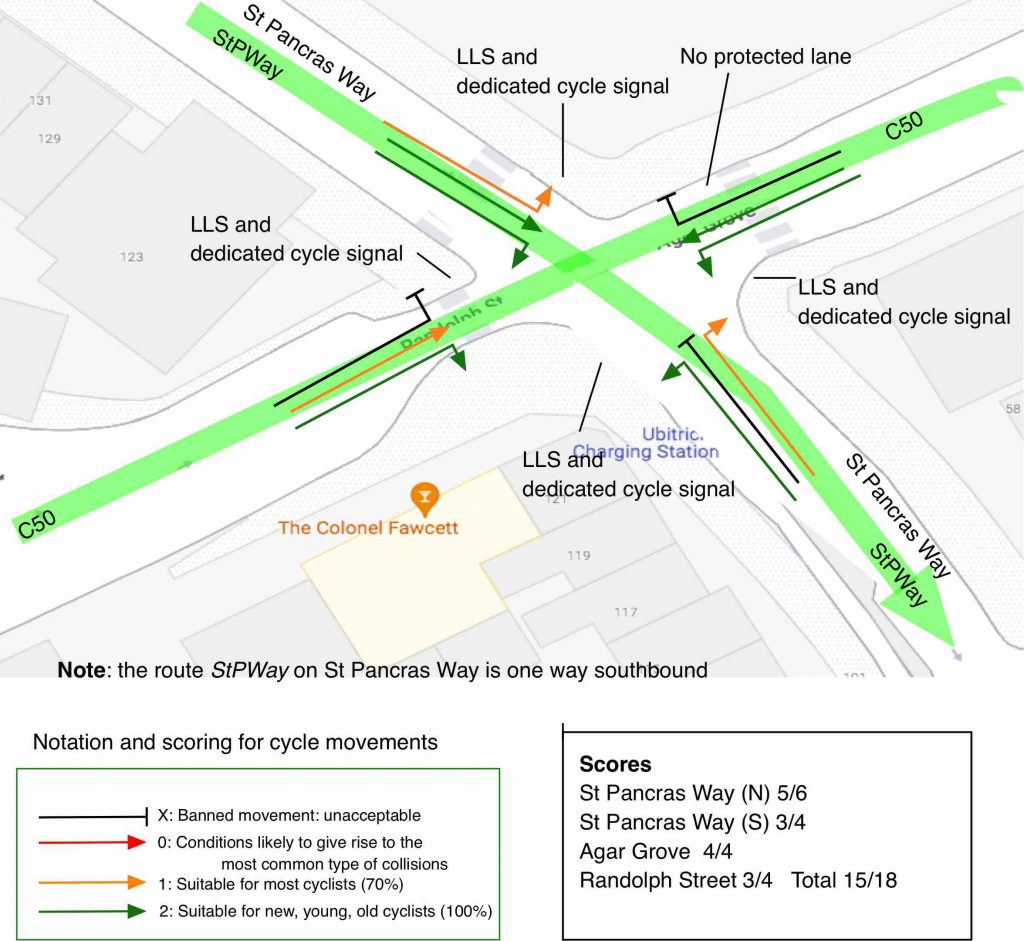 This junction has dedicated cycle signals on all four arms – the first one in Camden as far as we know.
This junction has dedicated cycle signals on all four arms – the first one in Camden as far as we know.
There are radical changes here:
- ability to cycle contraflow on Randolph Street
- no more push buttons on the northbound approach
- safe approaches and crossings on all four arms.
- with safe entries on two of them (it isn’t possible to turn north up St Pancras Way and there is no protection on the north side of Agar Grove).
We have awarded it a JAT† score of 15/18 . The score is out of 18 (rather than 24) because St Pancras Way is one-way southbound and therefore it’s not possible to turn north from any of the other three arms.
†JAT – Junction Assessment Tool – LTN 1/20
3. Agar Grove / Stratford Villas
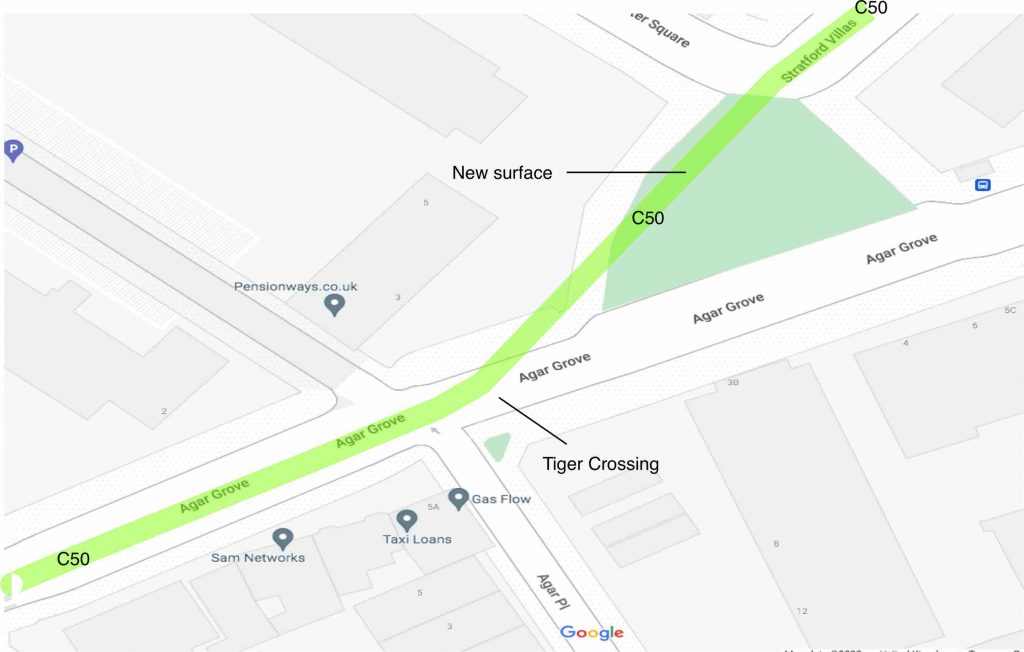
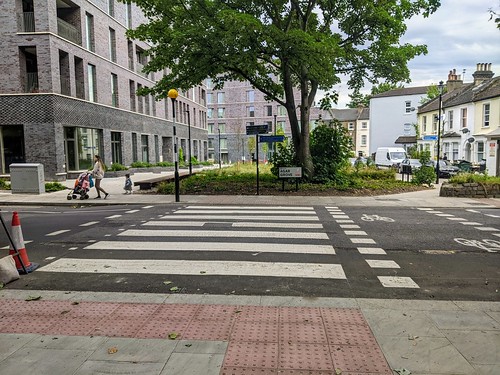
.
4. North Villas-Cliff Road / Camden Park Road
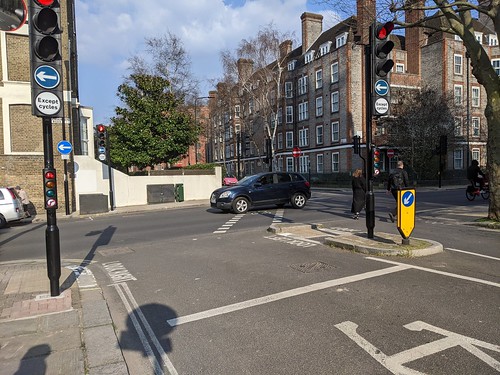
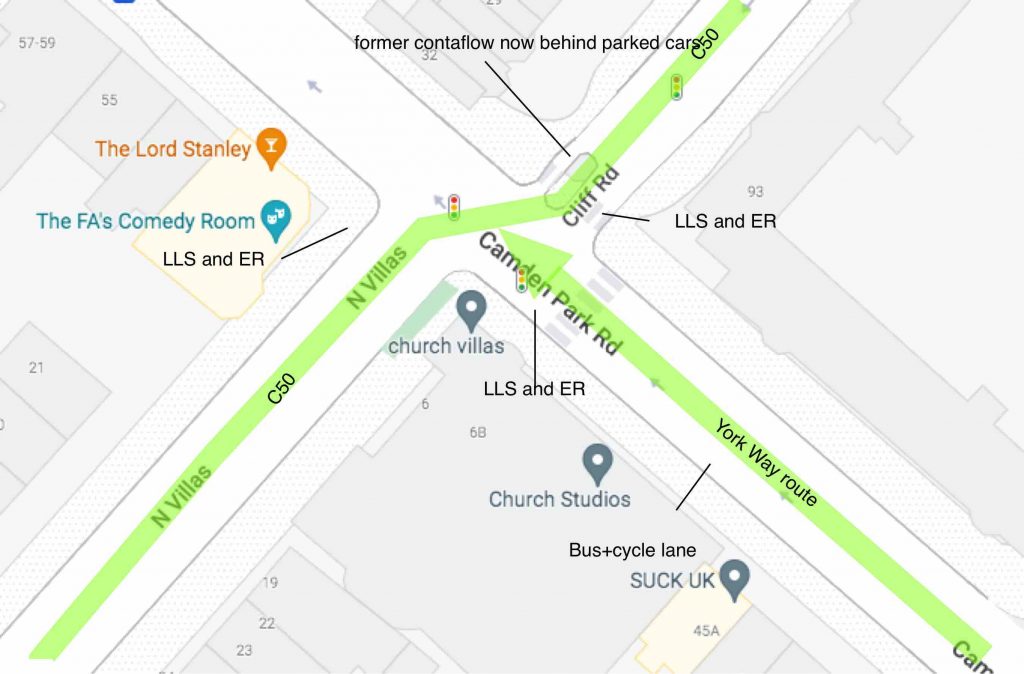
This junction was upgraded when the new Camden Park Road – Torriano Avenue scheme was put in, and Camden Park Road was upgraded the year before. See our report here. These improvements make this section of Camden Park Road a suitable northbound link to the C50 cycle route from the York Way cycle route.
Cliff Road is one-way westbound for motor vehicles but carries very little motor traffic. The new contraflow lane is behind the parked cars.
5. Cliff Road–Hungerford Road / York Way
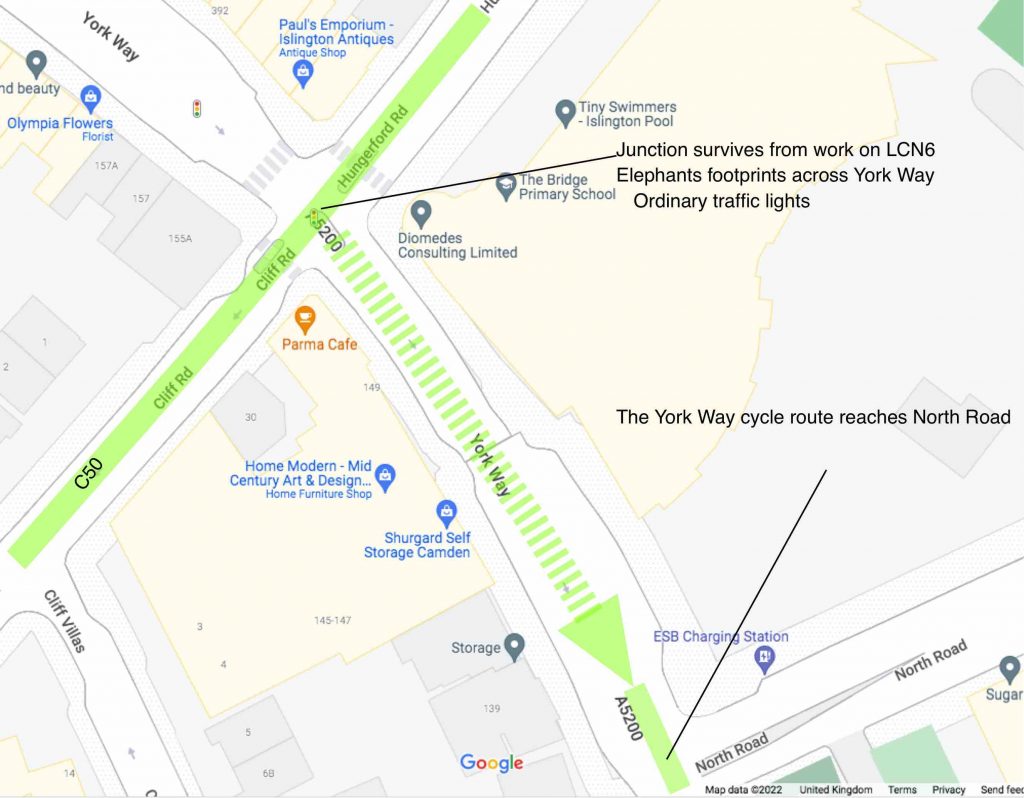
The designs for the agreed permanent scheme for the York Way cycle route show the infrastructure being extended from Hungerford Road down to North Way. They also include notes on altering the layout of the motor lanes.
We, therefore, look forward to seeing some improvements in this area in the near future.
Some closing observations
- We have seen the rapid development of a network of protected cycle lanes on main roads in Camden growing from about 8km in length in 2019 to about 25km now. However, enclosing roads in LTNs is another excellent way of providing safe cycling infrastructure. The part of the C50 route through the Camden Square LTN is about 3/4 km in length and is used in both directions resulting in a gain of 1.5km of safe cycling – including Randoph Street and Cliff Road the total is about 2km. We plan a further study of the northern end of the C6 route once the Grafton Road-Castlehaven Road / Prince of Wales Road junction has been improved with a view to calculating the gain in safe cycling from the Queen’s Crescent and Savernake LTNs.
- The Camden section of the C50 route is completed by Randolph Street with protected cycle lanes at one end and by Cliff Road at the other end. The junctions have been modified to provide safe crossings.
- Four of the five junctions described above (all but number 3) are at nodes in the cycle network: that is places where cycle routes intersect. For example, the C50 route intersects with the C6 route at the Royal College Street junction (number 1) and with the route on St Pancras Way (number 2).
- When we use the JAT we allocate full marks to dedicated cycle signals as at the Agar Grove-Randolph Street/ St Pancras Way junction provided that the approach and the exit are protected. But we have not yet been able to find criteria to use with the junctions without signals. e.g. the above implementations at Royal College Street / Randolph Street and Agar Grove / Stratford Villas. We need to decide so many things e.g. under what conditions a Tiger Crossing is suitable for all cyclists, the value of blue paint or a blended footway across a side road.
We would very much welcome input on how to measure the safety of junctions without signals.